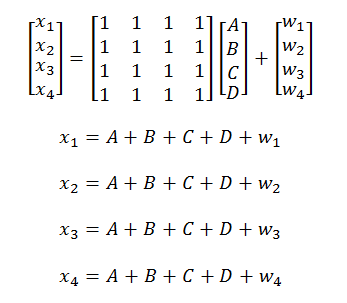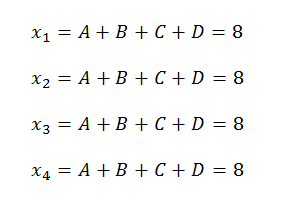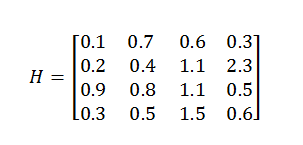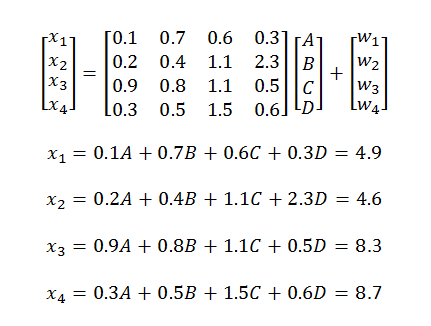In a previous post we have seen that MIMO fading capacity is much higher than AWGN capacity with multiple antennas. How is this possible? How can randomness added by a fading channel help us? In this post we try to find the reason for this. Let’s assume the following signal model for a Multi Input Multi Output antenna system.
x=Hs+w
Here s is the NT by 1 signal vector, w is the NR by 1 noise vector and H is the NR by NT channel matrix. The received signal vector is represented by x which has dimensions of NR by 1. In expanded form this can be written as (assuming NT =4 and NR =4):

Let’s assume that there is no fading and all entries of the channel matrix are equal to unity i.e. the channel provides no gain or phase rotation. Let’s further assume that the four transmitted symbols are A, B, C and D (real modulation like PAM is assumed). Then in an AWGN channel we have:

Let’s assume that A=1, B=3, C=5 and D=-1. Let’s further assume that there is no noise i.e. vector w is all zeros. The received signal vector x would then look like:

From linear algebra we know that to find four unknowns we need four independent equations. There is no way we can find the values of A, B, C and D from the above equations. To simplify the above equations we have removed AWGN but even in presence of AWGN we will have the same predicament.
This shows that in the absence of fading there is no multiplexing gain however high the Signal to Noise Ratio is (in the above example SNR is infinite). Now let’s assume that we have a 4×4 MIMO fading channel, which might now look something like this (a totally random matrix that this author could think of):

Substituting in the above linear model we have:

We have assumed that we are operating in the high SNR region where noise can be ignored. Now we have four nicely arranged linear independent equations that can be used to find four independent variables . So the fading channel does this magic to convert four dependent equations into four independent equations that can be easily solved (independence of equations can be checked by looking at the rank of channel matrix, which is 4 in this case).
There are a number of methods to solve the above system of equations but my preference is using matrix inversion using MATLAB function pinv (pseudo inverse). In case AWGN noise is added, the received vector x would deviate from the above and we might get some errors in estimation of the signal vector. Now looking back at the no fading case, we ask the question: is their a way to arrange the equations such that four variables A, B, C and D can be found?
One thought on “Why is MIMO Fading Capacity Higher than AWGN Capacity”
A very good topic and the numerical example has made it very interesting.
1- Can you mathematically describe a scenario where the Tx and Rx of the MIMO radar system have ULAs. Plane waves arrive at the Rx from 3 sources at angles of 35, 55 and 75 degrees? Assume 5 antennas at both Tx and Rx.
2- What is the difference between monostatic and bistatic MIMO radars. Explain them with the same above example.
3- Can we do research collaboration in this regard?